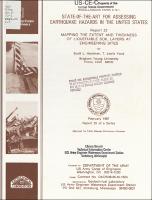Please use this identifier to cite or link to this item:
https://hdl.handle.net/11681/20699| Title: | State-of-the-art for assessing earthquake hazards in the United States. Report 22, Mapping the extent and thickness of liquefiable soil layers at engineering sites |
| Authors: | Brigham Young University. Department of Civil and Environmental Engineering Soils and Pavements Laboratory (U.S.) Bartlett, Steven F. Youd, T. Leslie |
| Keywords: | Earthquakes Embankment dams Earthquake hazards Earthquake risk Soil liquefaction Soil layers In situ testing Subsurface investigation Stratigraphy Equipment Testing Case studies |
| Publisher: | Geotechnical Laboratory (U.S.) Engineer Research and Development Center (U.S.) |
| Description: | Miscellaneous Paper Abstract: This study addresses the problem of mapping the subsurface extent and thickness of potentially liquefiable layers in a dam foundation. Accurate delineation of such materials is essential to evaluation of dam safety in seismic regions. Existing techniques for mapping liquefiable sediments are evaluated. Economics, limitations, and usefulness of each method in delineating soil layering are outlined. Case histories are examined which demonstrate the usefulness of each technique under field conditions. For most sediments, the cone penetrometer was found to be the most useful and economical technique for subsurface delineation of liquefiable soil layers. In all materials the cone was able to penetrate (including some gravel deposits), it gave high resolution and allowed identification of soil layers down to a few inches thick. In sediments too coarse for the cone to penetrate, the Becker drill may be a useful and economical reconnaissance tool. In gravelly and/or cobbly material, soil layers a foot or two in thickness are distinguishable from Becker blowcount logs, and retrieved samples. Standard Penetration Testing has been widely used, and is an excellent technique for use in conjunction with CPT. When only SPT Is used for profiling, delineation of layers is dependent on test spacing. The SPT may be used in most soil types, including some gravels. Continuous sampling by thin-walled tube is expensive, but provides complete definition of the soil profile. Tube sampling is not possible in materials containing more than about 20 percent gravel. The Central Mining and Equipment (CME) continuous sampler can retrieve core-samples up to 5 ft long that are very useful in soil profiling, but they are more disturbed than tube samples. The CME device is cheaper than piston tube sampling, and may be performed in any material which is augerable. However, samples taken by the CME sampler in loose gravels may be mixed and disturbed. Seismic velocity techniques and geophysical borehole logging are able to indicate a coarse profile of subsurface sediments, but are not very useful in detailed mapping of thin layers. To gain understanding concerning the minimum thickness of llquefiable layer which would be of concern to dam stability (and, thus, must be detected in subsurface investigation), experts in earthquake engineering were surveyed. A 1-ft criterion was found to be a general practical limit, but continuous thinner layers that might be coincident with a developing failure plane must also be delineated for critical structures. A parametric slope stability study was conducted to quantify the effect of length of liquefiable layer in an embankment. This analysis showed that the length of liquefied layer critical to the stability of an embankment dam increase with depth beneath the base of the dam. Results of this analysis, or a stability analysis of a dam in question can also be used as a general guide in selection of initial test and/or borehole spacings. Several field studies are reviewed to compare the usefulness, advantages, and disadvantages of the several exploratory techniques considered herein. NOTE: This file is large. Allow your browser several minutes to download the file. |
| Rights: | Approved for public release; distribution is unlimited. |
| URI: | http://hdl.handle.net/11681/20699 |
| Appears in Collections: | Miscellaneous Paper |
Files in This Item:
| File | Description | Size | Format | |
|---|---|---|---|---|
| MP-S-73-1-Report-22.pdf | 28.45 MB | Adobe PDF |  View/Open |